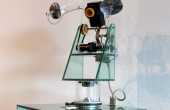Treva
Contributing writer for The Artifice.
Junior Contributor II
- Articles
1 - Featured
1 - Comments
12
- Ext. Comments
3 - Processed
0 - Revisions
0
- Topics
1 - Topics Taken
0 - Notes
2
- Topics Proc.
0 - Topics Rev.
0
- Points
170 - Rank
X - Score
82
Latest Articles
Latest Topics
Object-Oriented-Ontology and Indigenous Art PracticeOOOs, a brand of Speculative Realism supposes that objects have agency, an experience, a unique existence. This seems to have been an understanding long held by Indigenous Cultures in Canada and abroad. Though OOOs seem to have taken hold in contemporary Western philosophy and art practice (many examples can be seen in modern art galleries today) these knowledge systems have been around for much much longer in a different content. Who are some historical and contemporary Indigenous artists that practice under this system, what are they making and how can it be compared, or contrasted to Western practice? |
Latest Comments
| Lively Objects: Curating 'Broken' Electronic Art | |
Thank you for your comment. A very interesting and eerie proposition, and this is why I love speculative realism! A great thought experiment. | Lively Objects: Curating 'Broken' Electronic Art |
Thanks Denny! I think the phrase conjures up a great visual. Lots of old, worn and decaying media coming to life! So exciting! | Lively Objects: Curating 'Broken' Electronic Art |
Thanks for your feedback Correa. I don’t think we can make this distinction by comparing a baseball to an orange. As you say yourself art is defined by humans (it is a notion created by the human ontology). The AI is not defining itself as art, but rather, the many scholars, curators and artists who have worked in, commented on and created schools of thought around new media practice have deemed this type of robotic work to be art. I think today our ideas about what constitutes ‘Art’ have really broadened and are continuing to do so. | Lively Objects: Curating 'Broken' Electronic Art |
Amazing! He is incredible, such a fascinating guy. I was lucky enough to work with him while curating the exhibition I mentioned. | Lively Objects: Curating 'Broken' Electronic Art |
Thank you so much for your kind words Danielle! I so appreciate your feedback. It it really wonderful to hear that there is an interest in this type of weird and wonderful art work. | Lively Objects: Curating 'Broken' Electronic Art |
Absolutely, of course I am a great fan of his work. A pioneer and self-taught in regards to most of the technologies he uses which is really incredible. Innovation and perhaps a lack of resources in the 1960s and 1970s caused him to create some fascinating and weird work. | Lively Objects: Curating 'Broken' Electronic Art |
Thank you Dayton. I would argue otherwise. Art is always a product of some maker so the fact that these works are programmed by an artist does not negate their value as ‘Art’ nor as entities that appear as actors in an environment of relationships between viewers, spaces and things (here I am thinking of Latour’s Actor-Network-Theory). But of course art is subjective and though robotics and media art more generally are lacking scholarship in the greater art historical canon the medium(s) remain instrumental to contemporary artistic production. | Lively Objects: Curating 'Broken' Electronic Art |

I would like to attribute the term ‘Lively Objects’ to the research of Dr. Caroline Langill and Dr. Lizzie Muller.
Also, the exhibition Influenc(Ed.) Machines was inspired by the aforementioned research of Dr. Langill and Dr. Muller into the liveliness that characterizes new media art practice and exhibition.